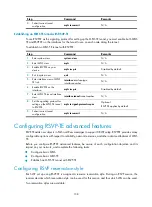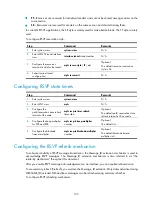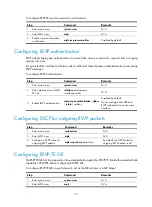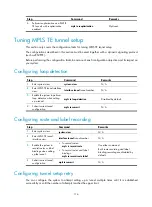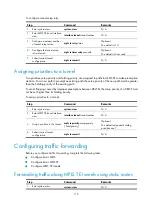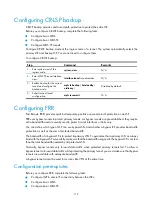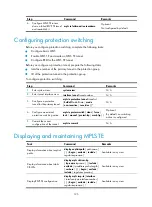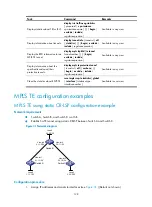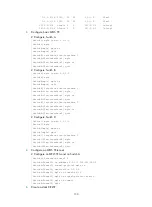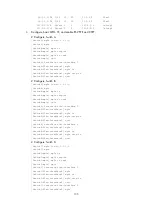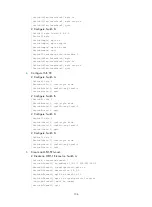
121
Step Command
Remarks
6.
Enter interface view of the
outgoing interface of the
protected LSP.
interface
interface-type
interface-number
N/A
7.
Bind the bypass tunnel with
the protected interface.
mpls te fast-reroute bypass-tunnel
tunnel
tunnel-number
N/A
Configuring node protection
RSVP hello extension is configured to detect node failures caused by problems such as signaling error
other than failures caused by link failures.
To use FRR for node protection, perform the following configuration on the PLR and the protected node:
Step Command
Remarks
1.
Enter system view.
system-view
N/A
2.
Enter MPLS view.
mpls
N/A
3.
Enable RSVP hello extension
on current node.
mpls rsvp-te hello
Disabled by default.
4.
Return to system view.
quit
N/A
5.
Enter the view of the interface
directly connected to the
protected node or PLR.
interface
interface-type
interface-number
N/A
6.
Enable RSVP hello extension
on the interface.
mpls rsvp-te hello
Disabled by default.
Configuring the FRR polling timer
The protection provided by FRR is temporary. Once a protected LSP becomes available again or a new
LSP is established, traffic is switched to the protected or new LSP. After this switchover, the PLR polls
available bypass tunnels for the best one at the regular interval specified by the FRR polling timer:
To configure the FRR polling timer:
Step Command
Remarks
1.
Enter system view of the PLR
node.
system-view
N/A
2.
Enter MPLS view.
mpls
N/A
3.
Configure the FRR polling
timer.
mpls te timer fast-reroute
[
seconds
]
Optional.
The FRR polling timer is 300
seconds by default.


